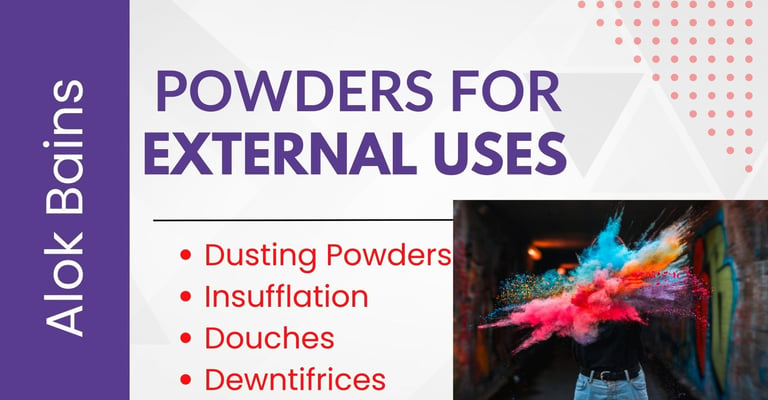Powders for External Uses
Powders for External Uses (Applications): Dusting Powder, Insuffalations, Douches and Dentifrices
PHARMACEUTICS
Alok Bains
9/29/20234 min read


POWDERS FOR EXTERNAL USES
Dusting Powders, Insuffalations, Douches and Dentifrices.
Dusting Powders: Dusting powders are homogeneously mixed finely divided powder particles of medicament or medicaments with or without excipients to be applied on the skin externally for local effect.
Dusting powders are examples of bulk powder. They are applied on the skin by using a sifter-top container, pressure aerosol, powder puff, soft brush, or sterile gauze without mechanical irritation to the skin. They are mainly used to produce antiseptic, antipruritic, astringent, adsorbent, antiperspirant, protective or lubricant action.
Properties of dusting powders
(i) Smooth texture: Dusting powders are homogeneous, and free-flowing, with very fine powder particles. It has a silky texture that feels very smooth on the skin.
(ii) Non-irritant: Dusting powders are gentle on the skin without any irritation.
(iii) Packaging: Dusting powders are dispensed in a sifter-top container, pressure aerosol, a container with powder puff, soft brush, or sterile gauze
(iv) Easy application: Dusting powders are dispensed in containers easy to deliver powders uniformly.
(v) Uniform spreadability: Dusting powders spread uniformly on the skin to cover the skin surface evenly.
(vi) Good adherence: Dusting powders adhere to the skin surface to produce an effect.
(vii) Adsorbent/Absorbent: Dusting powders have good absorbing or adsorbing properties to keep skin dry and reduce friction.
(viii) Effects on skin: Normally, dusting powders have ingredients that produce a cooling effect, soothe irritation, control odor, and reduce friction on the site of application.
(ix) Fragrance: Some dusting powders have pleasant fragrances such as body talcum powder.
(x) Talc-free powder: Some persons are allergic to talcum powder. Dusting powders are available without talc.
Dusting powder is considered a non-toxic preparation. However, its fine particles may be inhaled during its application. These fine powders cause irritation in the lungs and pulmonary embolism. Thus, the use of dusting powder should be avoided especially for infants. It must be applied on the skin with proper care.
Types of dusting powders:
There are two types of dusting powders: Pharmaceutical powder and medicated powder.
A. Pharmaceutical dusting powders: They are mainly used as pharmaceutical aids. Such as talcum powder, starch powder, magnesium stearate powder, etc.
a. Talcum Powders: It is a pharmaceutical powder with free-flowing properties. It produces lubricant and glidant effects in the manufacturing of tablets and capsules. This prevents the sticking of ingredients of tablets or capsules with the wall of the machinery.
Other than pharmaceutical aid, talcum powder is also used as body talcum powder to be sprinkled on the skin. It is mainly used as an adsorbent. It produces a cooling effect by adsorbing sweat from the skin. Evaporation of sweat consumes latent heat from the skin to produce a cooling effect. It may contain ingredients to produce a deodorant and fragrance effect.
Talcum is chemically inert with good adsorbent properties. But it is also sensitive to be contaminated with microorganisms especially “Clostridium tetani”. Thus only sterile talcum powder should be used.
b. Starch powders: Starch powder is used as a filler binder and disintegrating agent in tablet manufacturing. Starch is a carbohydrate and favor the growth of microorganism. Thus starch powder is not preferred for medical purposes.
c. Magnesium stearate powders: It is used as a lubricant in tablet manufacturing.
B. Medicated dusting powder
a. Zinc oxide powder: Zinc oxide is used as an ingredient in medicated dusting powder to produce a soothing and protective effect. It is commonly used to control diaper rash and minor skin irritation.
Formulation:
Sterile purified talc: 50gm
Powder starch: 25 gm
Zinc oxide: 25gm.
Precautions: In preparation, starch acts as an absorbent. Zinc oxide acts as an astringent, antiseptic, and adsorbent. Boric acid is not preferred as an ingredient in dusting powder. It is absorbed by the skin, especially from open skin, and produces toxic effects. It should not be applied on open skin except with surgical dusting powder.
b. Calamine powder: Calamine has astringent properties. It is used to treat skin conditions, sunburn, insect bites, etc.
c. Kaolin Clay Powder: Kaolin is a good adsorbent. It is used to adsorb toxins present in the intestine during diarrhea. It is anti-diarrheal.
d. Activated charcoal powder: It is good adsorbent. It is commonly used to adsorb toxins poisoning or overdose of the drug.
e. Clotrimazole powder: It is used as a dusting powder to treat fungal infections.
f. Surgical dusting powder: It is used as an antiseptic to treat wounds, burns, and on umbilical cord. It must be free from microorganisms and should be sterilized before use
Insufflation powder: It is finely divided powders to be administered into body cavities using apparatus insufflators. Examples of body cavities are ears, nose, vagina, throat, tooth sockets, etc. Insufflators introduce a stream of finely divided powders at the site of application. Powder particles stick to the mucus membrane in the body cavities. These particles are quickly absorbed into the bloodstream. It is not commonly used. It has been replaced by aerosols to deliver fine powders at the site of application. The main difficulties are blockage of apparatus by wet powder particles or by moisture present in side insufflators. It also does not deliver a uniform dose of the drug.
Douche powder: Douche powder is mixed with water and inserted into the vagina by using a douche applicator. It is mainly used to clean, deodorize the vaginal area and maintain feminine hygiene. It is not preferred by health professionals due to vaginal self-cleaning ability. Douches can disrupt the bacterial flora inside the vagina.
Dentifrices powder: Dentifrices are oral care products to clean teeth and massage gums to maintain oral hygiene. Example tooth powder.
